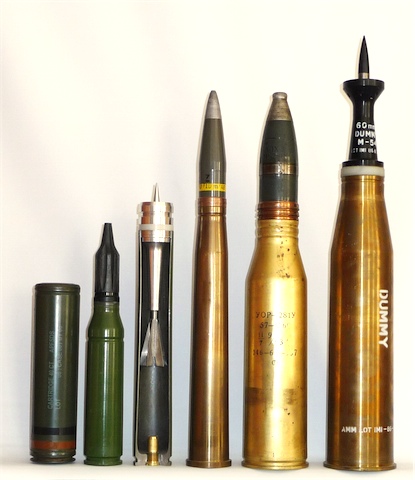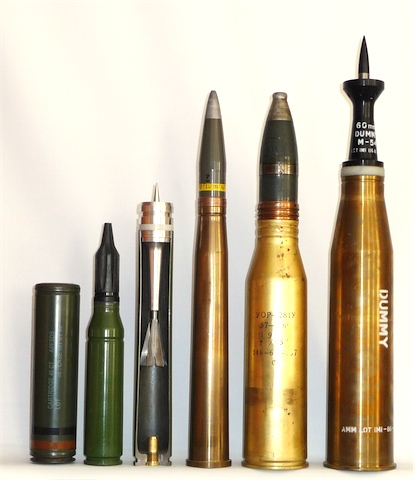No bud, I don't buy that.
This thing is simply not needed.
Of course it is needed.
The BMP had a 73mm gun with HEAT and later on HE Frag rounds, but the BMP-2 with its 30mm cannon was found to be more ideal in dealing with enemy helicopters and BMPs... the HE rounds were found to be useful against bunkers and other area targets on the battlefield... they were complimentary... the 30mm and ATGMs for armour and HE for soft and area targets on the ground.
The BMP-3 went a step further with a much better much longer ranged HE round but the 30mm was still adequate with improved AP ammo.
Well now the 30mm is not good enough... in terms of HE it was always marginal which is why the 73mm and 100mm were kept in service (note I am talking about BMP use... for BTRs then 30mm is fine, or even HMG).
The replacement for the 30mm and the 100mm is a 57mm but which one?
The competition was between a new essentially telescopic ammo grenade launcher/APFSDS round launcher 9A94, or the upgraded and improved S-60 anti aircraft gun the 9A91 which uses bottlenecked ammo the same as the ZSU-57-2 and towed S-60, but with a wide range of new ammo types being developed for it.
The advantage of the grenade launcher is much bigger HE bomb and before I knew about the APFSDS round... a lack of AP ammo which meant the S-60 gun round was a shoe in... despite the rounds being much bigger and heavier but with a less powerful HE projectile.
The trump card of the 9A94 gun is its APFSDS round... which will be much more powerful than any APFSDS round you could fit in a 30x165mm calibre shell in terms of length of propellent weight.
You have a low pressure tube that enables to fire projectiles .. let's be optimistic ... with 600-700m/s.
Why do you assume it is a low pressure tube?
The only reason the HE round has such a low velocity is because it is more than 90% projectile with a tiny short propellent stub... if the 125mm HE round only had propellent in the metal stub section its muzzle velocity would probably be lower too.
That is already double the regular pressure, so want to guess how it applies to the bore?
The weapon was designed from the outset to fire High velocity APFSDS rounds... why are you expecting it to struggle with the pressures this round would generate?
And why ...?
If you have w Bulat battery, and long range Kornet on hand?
Why even bother...?
Cost and weight. An APFSDS round is much more compact and cheaper and lighter than either Bulat or Kornet and if the target is within 3-400m and is stationary then why not take the shot with APFDS rounds?
Sure that 57mm rounds are in development, that is what spoils the view.
There are plenty of new rounds in development for both calibres because both calibres are going to be introduced... the 9A91 for the navy and army for air defence roles and 9A94 for BMPs for use against equivalent enemies...
It simply does not adds up. Think about that using your own experience, and turning off the wishful thinking.
No gains, tons of troubles.
No gains? A very powerful and effective low velocity HE round you can lob out to targets 6km away is amazing, and having a subcalibre high velocity APFSDS round with a bigger heavier longer dart than could be fitted in any 30mm cannon shell case, probably moving at 1.2 to 1.5km per second is the best of every world... in terms of ammo storage and amount of ammo carried and effect on target.
... and you have still shot it with 350-400m/s, or face a massive barrel detonation.
What are you talking about?
The weapon was intended to replace the 30mm cannon in the anti armour and anti soft target roles. For use against soft targets they went for max projectile weight which means it wont be moving very fast through the air at all. That does not matter because when you throw a hand grenade that explodes on impact the speed at which the round arrives means nothing compared to the size of the HE charge that bomb is carrying.
For anti armour use the projectile is tiny and super light weight and the enormous volume of the HE round is removed and replaced with extra propellent with a very light weight low drag projectile.
If you look at the American 20mm cannon for their fighter aircraft it has a small lightweight projectile and it leaves the barrel at over 1.1km/s. That was a choice.
The comparable Soviet round is the 23 x 115mm round that moves at 700m per second from the muzzle. The difference is in the projectile... the Soviet projectile has a heavy HE payload and is intended to do serious damage to anything it hits... the American 20mm is much smaller and relies on multiple hits from a gatling gun to be effective.
If you put the light projectile of the American round in the Soviet round and used a suitable propellent charge you would get a similar very high muzzle velocity.
The point is that the Americans are happy with flat shooting high velocity rounds and the Soviets slower heavier rounds also fired at very high rates of fire.
The Soviet guns wont explode if you put lighter projectiles with more propellent in them... and the American guns wont explode if you put heavier slower projectiles in them either.
Yes, really, because you are using just an opposite example.
You can add a 1/3 of powder to any barrel, but 3x the load to hardly any.
You are a way to smart&old to do that shit without purpose scratch
Are you trying to prove some agenda or something? scratch
I am not interested if so.
You seem to be under the impression that they have taken a low velocity grenade launcher and tried to load high velocity APFSDS ammo in it without any modifications to the design.
We have seen the ground based Grenade launcher, but what we have not seen is the aircraft mounted version for the Il-102 which was twin barrelled and designed to be aimed downwards at targets on the ground in a way to throw the sabots away from the aircraft to limit the chance they would be ingested into the engines. The Il-102 was shown with twin barrel 30mm guns on the centreline but there was a 57mm gun in development... do you think it likely an S-60 be mounted there or the 9A94 with much less recoil for APFSDS and for HE rounds...
Missiles of both Bastion and Arkan modes are loaded separately missles and charges, and by hand. So you can load as fast as a human can handle. The instruction says 6rpm, and that is still perfectly fine.
Manually loaded in the old mount, but with the upgraded system for the BMP-3M the autoloader carried 36 HE rounds and 6 missiles which are all loaded automatically.
Any estimate of loading speed depends on how they are loaded and how far the autoloader has to rotate to get the requested round... less of a problem on the BMP-3 than for a tank with multiple options for each autoloader position.
The old 57mm gun (S-60) had HE and AP rounds but they fired both together so both had to be similar weight and move at similar velocities for the both to hit the same point of aim at any distance. That reduced the AP performance of the old APHE rounds, which was not really very important because aircraft don't carry enough armour to protect from 30mm AP ammo let alone 57mm calibre rounds.
For a BMP role however you need better penetration than an AA gun would require so there are APFSDS rounds for both guns... don't think of them as high velocity and low velocity guns as they both have the capacity to fire high velocity rounds... but the old AA gun should manage better performance in that regard.
In terms of volume:

From right to left we have the 60mm Israeli mini anti tank round, the 57mm 9A91/S-60 round, then an old 40mm Bofors round, and then a new western 50mm round developed from a 35mm round but necked out to take a larger calibre projectile, then the 35 x 228mm round the 50mm round is based on and finally a 40mm telescoped round.
The 50mm round is obviously 7mm narrower than the 57mm 9A94 round but otherwise they look very very similar and as you can see would take up rather less space than the 57mm rounds that the 2S38 will be using as an air defence weapon.


 ALAMO
ALAMO



